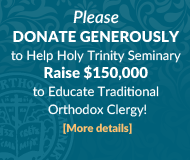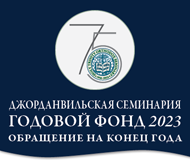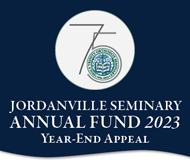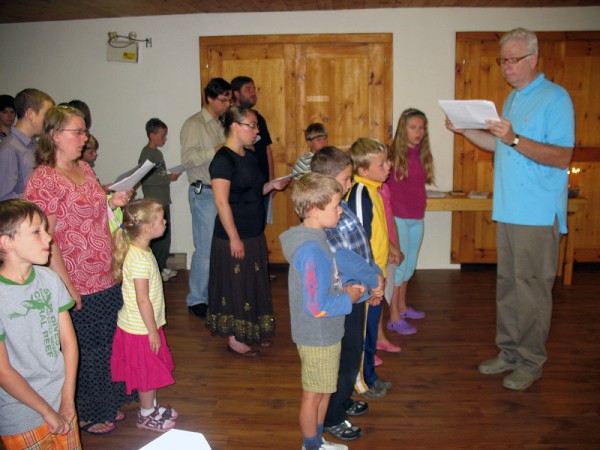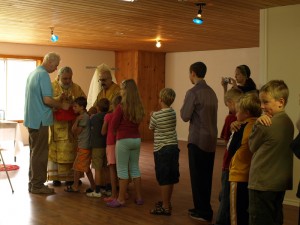News
-
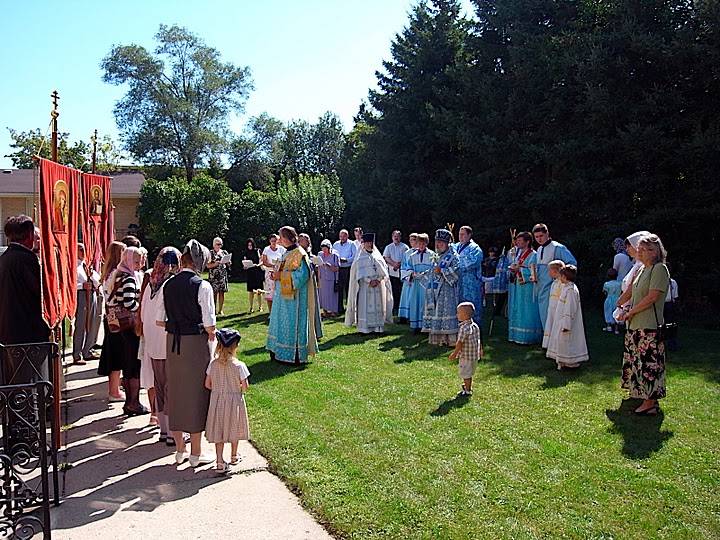
60th Anniversary of the Saviour Not Made with Hands Parish in London (Ontario)
10:23 AM
This year, the parish feast of the churh of the Icon of the Savior Not Made with Hands, celebrated as the third feast of the Savior, fell on the 60th anniversary of the parish.
On Sunday, August 16/29, with a large group of the faithful, His Grace, Gabriel, Bishop of Montreal and Canada, served Divine Liturgy assisted by the rector of the parish, Protopriest Vladimir Morin, Protodeacon Vasili Milonow (Protection Memorial Church, Ottawa, Ontario), and Deacon Alexander Morin (Holy Trinity Cathedral, Toronto, Ontario).
There was a cross procession with a prayer service. His Grace, Bishop Gabriel, blessed a memorial plaque, especially prepared for this feast day in honor of Ivan Vasilievitch Gavrilik, who in 1958 donated to the parish the plot of land, upon which the current church of the Icon of the Savior Not Made with Hands is erected. The plaque is for the eternal memory of the gracious benefactor’s son – Alexander, who died in a car accident at the age of 22.
After the cross procession and moleben everyone was invited to a meal.
Предлагаем читателям праздничный фоторепортаж, подготовленный Андреем Звонковым, прихожанином храма Нерукотворенного Спаса.
-
Celebration in honor of Archbishop Joasaph
10:02 AM
Thursday 14 October
m. Hilarion arrives late in the evening
Friday 15 October Rawdon
Church of Holy Virgin of Kazan Rawdon
- Greeting of m. Hilarion (10am)
- Panehida at Russian Cemetery (11 am)
- Meeting mayor of Rawdon
- Visit environs
- Trapeza
Friday 15 October Montreal
Visit Sts Peter and Paul Cathedral (2:30-3:30 pm)
Friday 15 October Montreal
Montreal City Hall (3:30-4:00pm)
Friday 15 October Montreal
- Matins (6pm)
Saturday 16 October Lachine
Church of St. John
- Greeting m. Hilarion (9am)
- Liturgy
- Trapeza
Saturday 16 October Cathedral
- Cossack Stanitsa Reception (2-3pm)
Saturday 16 October Cathedral
- Vespers (6pm)
Sunday 17 October Cathedral
Liturgy
- Greeting m. Hilarion (9am)
- Panehida
Trapeza Activities (12:30-15:30)
- The Enlightener Photos & Life
- Concert Quartet
- School
-
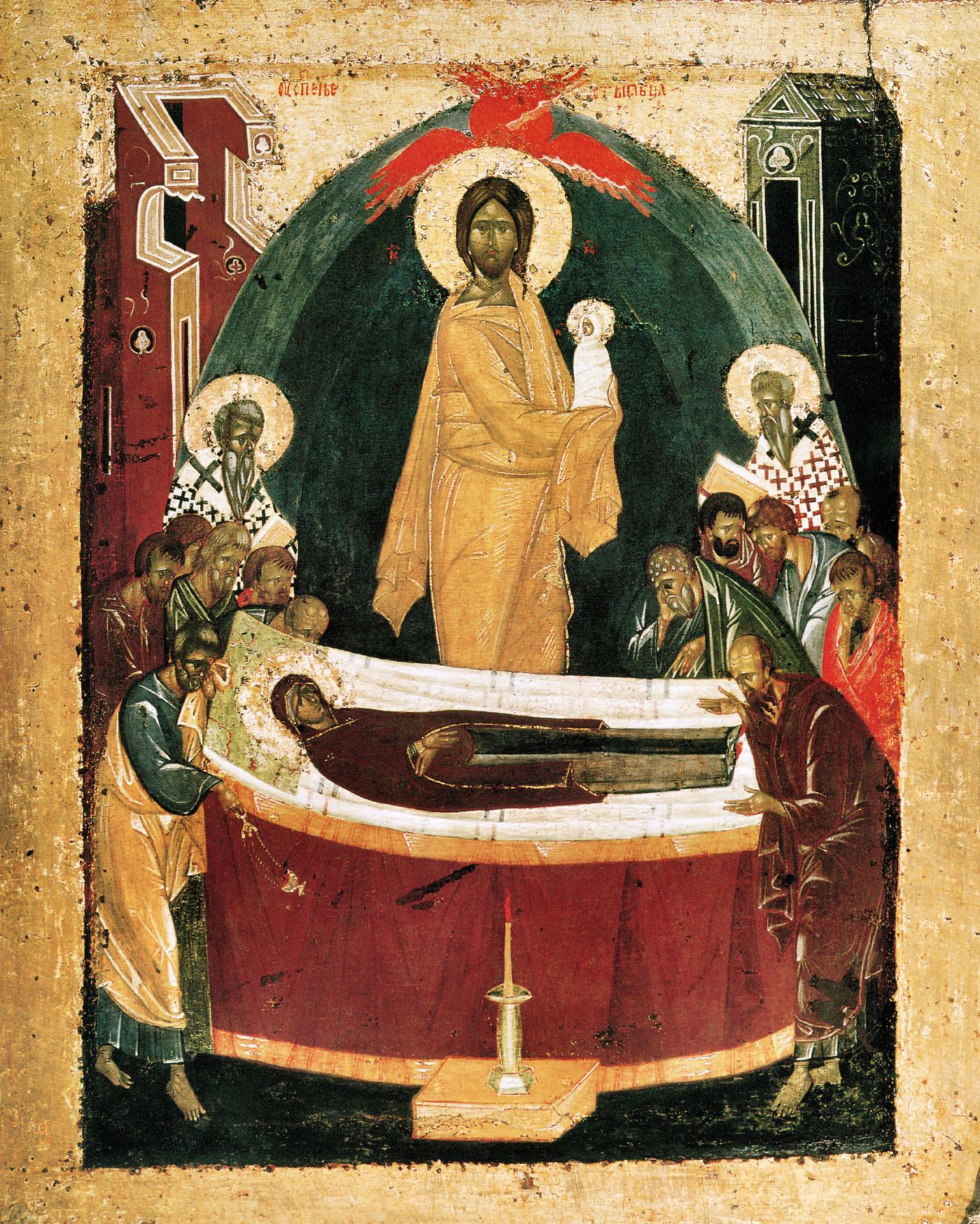
August 15/28 – Dormition of our Most Holy Glorious Mistress, the Theotokos and Ever-Virgin Mary
06:52 AM
After the ascension of the Lord, the Mother of God remained in the care of St. John the Theologian, and in his absence, she lived in the house of his parents near the mount of Olives. She planted and confirmed the Christian Church by Her presence, Her word, and Her prayers. During the persecution, initiated by Herod against the young Church of Christ (Acts 12:1-3), Most Holy Virgin Mary together with the apostle John the Theologian, in the year 43, moved to Ephesus, where it was his lot to preach the Gospel. She was also on Cyprus, visiting St. Lazarus the Four-days-dead, who was the bishop there, and on the Holy Mount Athos, of which, as says St. Stephen of the Holy Mountain, the Mother of God said prophetically: “This place shall be my lot, given to me by my Son and my God. I shall be a protectress of this place and an intercessor for it before God.”
According to the tradition preserved by the church historian Nicephoros Callistos (XIV cen.), the Mother of God “was of medium hight, or as some say, somewhat taller than medium; had golden hair; quick eyes, as though of olive color; brows bowing and somewhat elongated, elongated nose; flourishing lips, filled with sweet speeches; face neither round, nor sharp, but somewhat elongated; long hands and fingers… In speaking with others, She preserved pious appearance, didn’t laugh, didn’t become indignant, and especially didn’t get angry; perfectly natural, simple, She did not think anything of Herself, and far from being pampered, was distinguished by complete humility. Regarding the garments that She wore, She was satisfied with their natural colors, a fact to this day testified to by Her sacred head covering. Shortly speaking, in all Her actions a special grace was manifest”. (Nicephoros Callistos borrowed his description from St. Epiphanes of Cyprus +May 12, 403).
The circumstances of the Dormition of the Mother of God are known in the Orthodox Church from the apostolic times. In the first century hieromartyr Dionysius the Areopagite wrote about Her Dormition. In the fourth century, St. Epiphanes of Cyprus points to the tradition regarding the Dormition of the Mother of God. In the fifth century, St. Juvenal, the Patriarch of Jerusalem, said to the holy right-believing Greek empress Pulcheria: “Even though there is no narrative about the circumstances of Her passing in the Holy Scriptures, still, we know about them from the most ancient and most true tradition”.
For the time of Her blessed Dormition the Most Holy Virgin Mary once again came to Jerusalem. She spent days and nights in prayer. Often, the Most Holy Theotokos came to the Holy Tomb of the Lord, offered incense there and bowed Her knees. Many times, the enemies of the Savior attempted to prevent Her from visiting the holy place and asked high priests for guards to watch at the Lord’s Tomb. Yet, the Holy Virgin, unseen by anyone, continued to pray before it.
According to the testimony of the byzantine Church historian George Kedrin, the falling asleep of the Theotokos was preceded by somewhat of a second Annunciation: “Once, the Most Holy Virgin, was praying on Her knees at the very place, where Her Son was praying about the Divine Cup, – then, suddenly, Archangel Gabriel stood before Her, and giving Her the sign of victory over bodily death, a branch of date palm from paradise, – announced Her imminent passing, that would come about in three days”. George Kedrin writes that this branch, after Dormition, was carried before the bier of the Theotokos by St. John the Theologian.
On the third day after Dormition of the Theotokos the unconsolable apostle Thomas came to Gethsemane and weeping bowed before the cave of the tomb. Taking pity for his sorrow, the other disciples agreed to move the stone, covering the entry into the tomb, away, however, the Most Pure Body was no longer in it because the Most Holy Theotokos “fell asleep in death for a short time as though for a short sleep, and soon as though from sleep, arose and shook off the death in the tomb as sleep from Her eys, and saw in the light of the Lord’s Countenance eternal life and glory” (From the canon for the feast of Dormition).
Testimonies remain that at the end of the seventh century there existed over the underground church of the Dormition of the Most Holy Theotokos a church, from the tall bell tower of which one could see the dome of the church of the Resurrection of the Lord. Now, there are no visible signs of the existence of this church. In the ninth century, next to the underground Gethsemane church a monastery was built, that was inhabited by 30 monks.
In 1009 the church suffered great damage from the persecutor of the holy places, calif Hakim. Significant changes, traces of which remain to this day, were made by the crusaders. In the eleventh and twelfth centuries, a portion of cut stone, upon which the Lord prayed on the night of His betrayal, disappeared from Jerusalem. Until the sixth century, this portion of the stone was in the Gethsemane basilica.
Yet, despite destruction and changes, the general initial cross-shaped plan of the church is preserved until today.
Wondrous was the life of the Most Pure Virgin, wondrous also was Her Dormition, as the Holy Church chants: “The God of the universe manifests in Thee, O Queen, wonders above the laws of nature. At the time of Nativity, He preserved Thy virginity, and in the tomb He preserved Thy body from corruption” (Canon 1, Ode 6, Troparion 1).
-
2010 Fall Pastoral Clergy Gathering to be Held in Vancouver, BC
09:23 PM
The annual fall Pastoral gathering of the diocesan clergy this year will take place at the Holy Trinity church in Vancouver, British Columbia. The event will be held from October 5/18th until October 7/20th, 2010. The program of the meeting will be published in the nearest future.
-

August 6/19 – Holy Transfiguration of Our Lord God and Savior Jesus Christ
12:00 PM
In the Transfiguration of the Lord the mystical nature of the One, Who in those days was called a Nazarene or a Prophet, instantly became manifest to the three disciples whom He chose Himself, or, in the church language, this Nature manifested Itself through the human flesh of Jesus. Apostles Peter, James, and John saw the Son, Whose countenance shone “like the son”, “His garments became shining, very white, like the snow, white like no person on earth could make them.” At the same time the Apostles felt upon themselves tangible “grace of the Holy Spirit, coming like a noetic light, bringing joy” (from the words of St. Symeon the New Theologian). When, for a time, penetrated by this light Peter cried out: “Lord! It is good for us to be here”, the voice of the Heavenly Father, that said: “This is My beloved Son, in Whom I am well pleased; listen unto Him” (Matthew 17:4) became intelligible to him, to James and to John.
The author of the third Gospel, holy apostle Luke, in his description of the Transfiguration, lists three most important details: the appearance of the Lord’s “countenance” changed during prayer; Prophets Moses and Elias talked with Jesus “about His passing, which He had to accomplish in Jerusalem” (Luke 9:31); the disciples themselves were “heavy with sleep” and that , in a way, foreshadowed the overwhelming black sleepiness that was soon to come upon the apostles in the garden of Gethsemane.
“The Prophets and Apostles were filled with joy, – says St. Ephraim the Syrian. – The Prophets rejoiced, because they saw here His humanity that they didn’t see before, the Apostles rejoiced, because they saw here the glory of His Divinity that they didn’t know before.”
The church tradition, going back at least to the third century of christian era, states that Transfiguration took place upon mount Tabor, in the southern part of Galilee.
“Mount Tabor, heaven on earth, exultation of the soul and the nourishment of the eyes of the orthodox: because some divine grace is present, overshadowing the mountain, and that inspires spiritual joy”, – wrote a greek from Crete, the author of the pilgrim’s notes John Phocas, whose visit to the Holy Places of Palestine took place in the year 1187. Yet, it is difficult to say what exactly did he see upon mount Tabor: some sources say that already in 1181 the armies of calif Saladdin destroyed the local monasteries and churches, killing the monks, and built a fortress on the ruins in order to ward off the attacks of the crusaders.
“In the year 1217, crowds of the crusaders, made up of pilgrims, gathered under the direction of the kings: Andrew of Hungary, Hugo of Cypress, and John of Jerusalem, on the day of St. Andrew camped at the foot of Mount Tabor against the fortress situated at the top” – says professor of divinity Benjamin Ioannidis, author of a recent and famous description of the Holy Land. – The Saracen garrison, as soon as the approaching army of the crusaders was spotted, set out against them at the gates of the fortress… Many of the cavaliers of the Orders of St. John and of the Temple died without any success…”.
A century earlier, the glorified “Igumen of the Russian Land” Daniel mentions the churches on Tabor in his “Pilgrimage”: “There is a high place at the very top of that mountain, as if a rock, small and sharp at the top, that is the place where Christ our God was transfigured; there is a good church in honor of Transfiguration there, and another one in honor of the holy prophets Moses and Elias.”.
Later on, all of this disappeared at the efforts of the destroyers, and only in the 19th century, greek Orthodox church was built on Tabor, where one can see the remains of the buildings from the times of St. Helena, mother of holy equal-to-the-apostles Emperor Constantine. The guide for the Russian pilgrims, published in 1894, says: “Pilgrims spend almost an hour in order to climb the mountain of Transfiguration. At the wall of the greek monastery the caravan is met by bell ringing and the pilgrims go straight into the church… Having worshipped at the holy place, they settle within the walls of the monastery in any way they can. The entire building of the monastery, even the church, is wide open to receive the travelers from afar. In the evening, our Russian hieromonks, along with all the brethren of Tabor, clergy from the pilgrims and in the presence of the Metropolitan (of Nazareth) serve the all-night vigil, and later on, closer to sunrise, Liturgy in church slavonic.”
The shining of the light of Tabor – uncreated light – right next to the sleeping sinful people contains within itself a promise: “It is impossible for Him not to enlighten those, who in a worthy manner participate in the Divine radiance of His Body within us”, – writes St. Gregory Palamas. It was specifically in this manner that St. Seraphim of Sarov vouchsafed his friend and disciple N.A. Motovilov to become a fellow seer and fellow participant in being in the Light of the Transfiguration. “Imagine, in the middle of the sun, in the very brilliant radiance of its noon rays, the face of the man, who is speaking with you. You see the movement of his lips, the changing expression of his eyes, hear his voice, but see neither yourself, nor his figure, save for solely the blinding light, spreading far, and illuminating with its bright shining the snow, which covers the meadow, along with the snow flakes, covering from above both me and the Great Elder”, – related Motovilov about what took place.
In continuation of the Old Testament tradition, the fruit of the earth – ears of grain and grapes, “for from them comes the wine for the bloodless sacrifice”, are blessed on the feast of Transfiguration. Usually, in Russia apples are blessed. The Church entreats the Lord, that He grant to those eating the fruits sanctification of the soul together with the sanctification of the body, that He would keep their life in peace and joy, and that He multiply the fruits. The Church of Christ blesses and sanctifies the offered fruits with the holy Name of God, glorified in the Trinity.
-

About the One Thing Needful
09:45 PM
There appeared on the internet a reply to the Synod of Bishops’ open letter addressed to the suspended clergy of the South American Diocese of the Church Abroad (http://russianorthodoxchurch.ws/synod/2010/sadioceseletter.html). The author of this reply is the defrocked bishop Agathangel Pashkovskiy, who calls himself “metropolitan” (http://sinod.ruschurchabroad.org/100804.htm).
Neither the letter of the Synod, nor the preceding appeal to the Synod from the South American clergy were addressed to the former bishop Agathangel.
However, we decided to reply to his commentaries since our letters are addressed not only to Latin America, but are intended for all, who came to be outside of the Church’s fold.
First of all, we assure former bishop Agathangel that, despite his feelings, the letter of the Synod of Bishops, to which he responded, was not written in Russia. Its collective authors were exclusively native members of the ROCOR, who were never in another jurisdiction, not even for a day. These individuals can in no way be numbered among the “contemporary Russians” because most of them were born outside the borders of our Historic Fatherland. It also is not clear where in the letter of the Synod of Bishop did the former bishop Agathangel find the call to “return to Russian Federation”, as well as the statements “as though in Russia all is well”.
Persistent accusations in “slanting”, “falsehood” and other rest wholly on the conscience of the former bishop Agathangel. His ambition is to claim the South American diocese of the Russian Church Abroad. Yet, upon what grounds? In reality, as any interested reader may easily find out, the case is as follows: according to Part IV, paragraph 37, point “n” of the current Regulations of ROCOR, “in case of a vacant episcopal see, to take upon himself temporary control of it or to assign a bishop before the appointment of a Ruling Bishop”. That is exactly what happened after the repose of His Grace, Bishop Alexander of South America. And it was exactly the same situation that came to be after the self-initiated creation and heading of the so-called “PSEA” by the former bishop Agathangel, which meant nothing other than his refusal to obey the Synod of Bishops that issued the decree about the appointment of former bishop Agathangel to the South American cathedra. Consequently, former bishop Agathangel could then in no way claim the administration of the South American Diocese of ROCOR and that was clearly understood by the clergy of that diocese. That is the reason why some of them have petitioned Vladyka Metropolitan Laurus, as their ruling hierarch, with the request for a “canonical release”, that being the subject of discussion in their letter. We are left only to quote the words of the former bishop Agathangel, applying what he wrote to his own case: “That is known by every native member of ROCOR, the author also knows it, but he writes a lie in order to confuse the readers”.
Speaking of ecumenism, former bishop Agathangel sites history and tradition instead of the Holy Canons quite intentionally. Both (history and tradition) unlike the Holy Canons, proceed “from man and according to man” and that is why they are always confirmed by the catholic (soborny) divinely inspired mind of the Church. For example, until a particular time the Church accepted considerably more New Testament scriptures than it does now. However, can we say that our Four Gospels are the breaking of the “historic traditions”, “traditions of the elders”? The well-known statement of our Council of Bishops of the Church Abroad of the year 1983, when the teaching of ecumenism was anathematised is only the opinion, the position pronounced by the part of the Local Russian Church. By the way, that was said by the ever-memorable Metropolitan Vitaly, whose views on ecumenism are well known to all. At the same time in the Local Russian Church, both in the Fatherland and abroad, joint services together with the heterodox were never permitted and the idea of the “plurality of the truth” was never preached. The external position of the Church Abroad remains immovable: thus, in the year 2008, His Eminence, the Very Most Reverend Metropolitan Hilarion, in his presentation in Moscow, once again called upon the Russian Orthodox Church to leave the World Council of Churches. His appeal, originating within our entire Russian Church Abroad, finds ever greater numbers of supporters among the hierarchs in the homeland.
The former bishop Agathangel calls “sergianism” a sin. Yet, he forgets, that the sin, expressed in the unworthy and in the end useless attempts of the Church authorities to find a common language with the earthly powers hostile to Christianity, is not foreign to himself. When he was a hierarch, Agathangel Pashkovskiy always exhibited an excessive inclination to participate in political campaigns. During the presidential election in 2004 in the Ukraine he held very close ties with one of the candidates, in reality taking part in the so-called “orange revolution”. The name of the former bishop Agathangel is associated with one of the most criticised city mayors and that was in no way beneficial for the Church. Now, of course, he is free to do as he minds. In any case, however, the fate of the hierarchy of the Russian Orthodox Church in the Fatherland, who, according to the words of St. John of Shanghai and San Francisco, had to keep Orthodoxy on the surface of the Russian life by suffering on the cross, is in no way diminished to such accusations.
Speaking of the “unlawful seizure of churches in Suzdal”, the former bishop Agathangel for some reason fails to mention from whom these churches were seized. We are speaking of the self-styled schismatic group “ROAC” of the twice defrocked Valentine Rousantsev. The transfer of these Suzdal churches to the Orthodox Church is at least as lawful as the transfer of the seized Church properties in other Russian cities, where churches were made into warehouses, clubs, museums and prisons.
The given example confirms the very fact that there are no more persecutions of the Church in today’s Russia.
Carried away by political insinuations, former bishop Agathangel stubbornly refuses to talk about the main content of the letter of the Synod of Bishops: about the division of the Church.
We did not say a word about secular affairs. We only said that the clergy, who left the fold of the Church, who made up a self-styled gathering, lost the right and the ability to perform the Mysteries. Those, who dare to serve despite being suspended, in accordance with the Holy Canons, defrock themselves. It means that both they, and the ones who approach them as pastors, are deprived of the grace-filled Mysteries, which are the only way to salvation.
It is of nothing else, but only of this, the one thing needful, we whole-heartedly whish that they would think while it is not too late.
GABRIEL,
Bishop of Montreal & Canada
Permanent member of the Synod of Bishops -
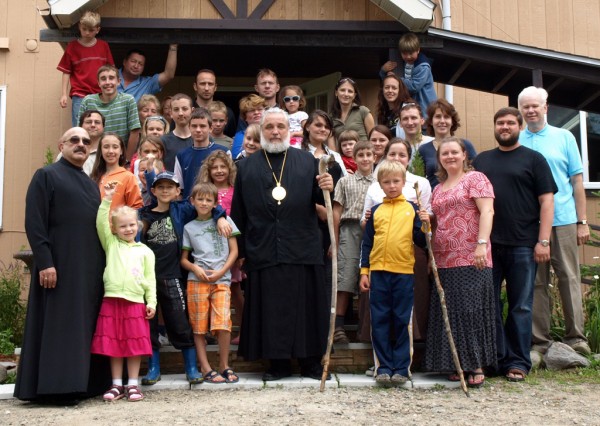
Ss. Boris & Gleb’s children’s summer camp of the A.S. Pushkin’s parish school completed this season
09:32 AM
On August 8 the annual Ss. Boris & Gleb’s children’s summer camp of the A.S. Pushkin’s parish school (www.pushkinschool.org) at St. Nicholas cathedral in Montreal, Quebec, completed this season.
This year the camp was organized in a beautiful valley north of Montreal in the area of Val-Des-Lacs.
A spacious two story cottage, with many comfortable rooms, a large dining room, well-equipped kitchen, and roomy hall, is situated there next to a mountain brook, surrounded by park forests. Next to the cottage is a fenced in swimming pool.
Aside from the various excursions, fishing, and of course, playing in the open air in grass covered fields, the children – during the lessons in the Law of God – prepared for the traditional divine service at the end of the summer rest.
On Sunday morning, in the hall decorated with flowers, His Grace, Gabriel, Bishop of Montreal & Canada, served the Divine Liturgy. The children’s choir, conducted by subdeacon Grigoriy Vasilievitch Borovik, sang melodiously and beautifully. Of almost forty people present – young and old – majority confessed and received Holy Communion.
After the dismissal of the Liturgy, everyone was invited to the festive meal. The main dish, for the majority, was the freshly cooked fish that the young fishermen caught at the dawn of the same day.
